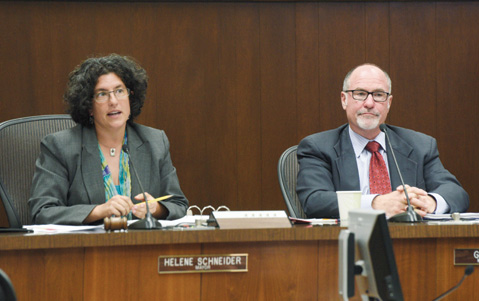Santa Barbara Says No to Oil Train
Venoco Seeks Emergency Trucking Permit

Venoco, Inc. on Monday applied for an emergency permit with the City of Goleta to truck about 5,500 barrels of emulsified crude oil now trapped on Platform Holly within the pipeline to the Onshore Ellwood Facility and inside several storage vessels and containers. Venoco’s facilities have been effectively shut down since the May 19 Refugio Oil Spill.
Venoco officials made clear they are not seeking permission to truck so that they can resume production, as ExxonMobil tried but failed to do three weeks after the spill. Instead, Venoco explained, it needs to purge its facilities to allow certain inspections scheduled for next month to take place. Those inspections, Venoco stated, are required for it to remain in compliance with existing permits.
The company estimates it would need to haul two truckloads of oil a day for 17 days to complete the job. ExxonMobil, which has stored eight times as much oil as Venoco, sought permits to haul eight trucks an hour out of its Las Flores Canyon facility, 24 hours a day. In its application, Venoco argued that the water “entrained” with the oil and marooned in the company’s infrastructure was “settling to the bottom of the tanks and pipelines, increasing the risk of tank and pipeline corrosion.” To address this, the company said, oil must be removed so repairs can be made. Should trucking be allowed, Venoco stated it would haul the oil to Phillips 66 in Santa Maria or the Crimson Pipeline tank, located in Santa Paula.
Goleta spokesperson Valerie Kushnerov stated that the application has been deemed “incomplete” by city planners and that she expects Venoco to submit an amended application. It remains uncertain who or what entity within City Hall would make such a call: the City Council or planning director. Writing a letter of support for Venoco’s application was executive officer of the California State Lands Commission Jennifer Lucchesi.
How long the Plains All American pipeline remains shut down is a matter of intense speculation; according to some industry sources, the federal agency responsible for pipeline safety could issue its cleanup order by mid August, detailing just how extensive — and time consuming — the remediation efforts will be.
In related news, Plains spokesperson Meredith Mathews confirmed reports that Plains officer Chris Herbold sold 12,700 shares of Plains stock — reported in other news sources as being worth $600,000 — the day of the spill. Mathews noted that the sale took place at 9:30 a.m. in the morning, more than hour before the first pressure drop in the Refugio pipeline was reported, and several hours before the spill itself was detected. She added that Herbold’s stock sale had been vested by Plains four days prior.
The Santa Barbara City Council voted 5-2 to write a letter urging that San Luis Obispo reject an application by Phillips 66 to expand the railroad spur at its Nipomo refinery, thus creating the space necessary for a 1.4-mile-long train — carrying up to 80 cars of oil — to use the facility as a destination. Mayor Helene Schneider and Councilmember Gregg Hart put the item before the council, arguing the risk posed by the five oil trains expected per week was unacceptable.
Critics of the proposed oil train packed the council chambers, recounting the horrors that happened in North Dakota, West Virginia, and Quebec, when similarly laden trains jumped the tracks there. Displaying a map showing the “blast zone” along both sides of the railroad tracks, speaker after speaker itemized the defining structures and urban landmarks that could be affected: 16 schools, one fire station, Chase Palm Park, Stearns Wharf, City Hall, and the Funk Zone. Linda Krop, attorney for the Environmental Defense Center, noted that even the city’s Municipal Golf Course — the subject of intense council debate earlier in the day — was at risk. “That’s the last straw,” Krop said, precipitating an outburst of laughter.
Opposing the anti-oil train letter were councilmembers Frank Hotchkiss and Dale Francisco. “I wish you didn’t have the great fear that you do,” said Hotchkiss to those assembled, “but you do.” Francisco argued that the train cars carrying oil to Phillips 66 had all been manufactured since 2012, adhering to stricter safety regulations than those imposed by the federal Department of Transportation.
In drafting a letter, Santa Barbara joins a list of 40 cities and other governmental entities along the coast in opposing the oil train rail spur, including Goleta, Carpinteria, Ventura County, and the City of San Luis Obispo. The matter is next scheduled to be heard by the SLO Planning Commission.



